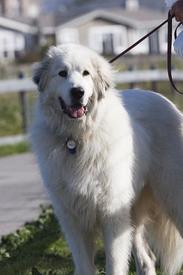
Deriving its name from the Pyrenees Mountains of France where it was traditionally utilised as a livestock guardian, the breed is thought to have originated from Siberia or Central Asia, having descended from the Hungarian Kuvasz and the Maremmano Abruzzese. Well suited to many working fulfillments, the Great Pyrenees became popular with the French nobility as a guard dog prior to the Revolution, used to protect wealthy chateaux and stable yards. Records of the Great Pyrenees pre-date the Bronze Age of 1800-1000 BC, making it one of the world's ancient breeds. During the Second World War the dog was enlisted as a message carrier, doggedly transporting its message through shellfire to reach its recipient. The Great Pyrenees was officially recognised by the American Kennel Club in 1933.
Highly distinctive in appearance, the Great Pyrenees is a powerful and broad-chested breed, possessing a domed forehead, a black nose and lips, small, low-set ears and a profuse double coat. The coat is weather-resistant, serving to protect the dog from extremes in temperature, whilst safeguarding against the daily wear and tear of farm work and rough mountain terrain. A striking resemblance is observed between the Great Pyrenees and St. Bernard, suggesting it is an early forebear of the breed. Due to the Great Pyrenees' good looks, the breed frequently appears in French films.
Only moderately active, the Great Pyrenees is low maintenance when it comes to ensuring sufficient exercise. With an inherent temperament to guard and protect, the breed makes a great watch dog, alerting its master to change or threat whilst displaying gentle and affectionate behaviours unprovoked. Highly compatible with children and other house pets, the Great Pyrenees is well suited to the domestic setting, making a great addition to active family life. On average, a healthy Pyrenees will weigh 38-45 kg depending on its gender, with a life expectancy of 10-12 years.
Most large breeds are susceptible to heart disease, with common conditions including tricuspid valve dysplasia and cardiac weakness. Orthopedic disorders are also well documented, with patellar luxation and hip dysplasia being particularly common. Additionally, the Great Pyrenees is prone to optical disorders, digestive bloat and tortion, and various cancers.

Sehr geehrte Kunden von VioVet Deutschland,
Ab dem 31. Oktober 2018 ist die viovet.de Webseite nicht mehr aktiv und die VioVet GmbH stellt den Handel ein. Wenn Sie dennoch bei VioVet Ltd (UK) einkaufen möchten, können Sie ein neues Konto bei viovet.co.uk erstellen. Wenn Sie Fragen zu einer Bestellung haben, die Sie auf viovet.de aufgegeben haben, dann kontaktieren Sie uns bitte hier [email protected].
Die viovet.co.uk-Website ist derzeit nur auf Englisch und in GBP (£) verfügbar aber unser Team arbeiten in den kommenden Monaten daran, Sprachen und Währungen hinzuzufügen.
Wir möchten uns ganz herzlich für Ihre Treue als Kunde bedanken.
Mit freundlichen Grüßen,
Ihr VioVet Deutschland Team
Do you own a Great Pyrenees? Let others know what they're like!
Related products
Advantage 80 Spot On Flea Control Large Cats and Rabbits
from £12.95
Advantage 40 Spot On Flea Control Cats, Small Dogs and Rabbits
from £12.95
Advantage 250 Spot On Flea Control Large Dog
from £12.95
Advantage 100 Spot On Flea Control Medium Dog
from £12.95
TermaWorm™ Tablets for Cats & Dogs
from £1.59
Drontal Tasty Bone Wormer Tablets for Small & Medium Dogs (2 to 20kg)
from £2.15
FRONTLINE Plus Flea & Tick Treatment Dogs & Cats
from £17.49
Drontal Tasty Bone XL Wormer Tablets for Large Dogs (Over 20kg)
from £6.39